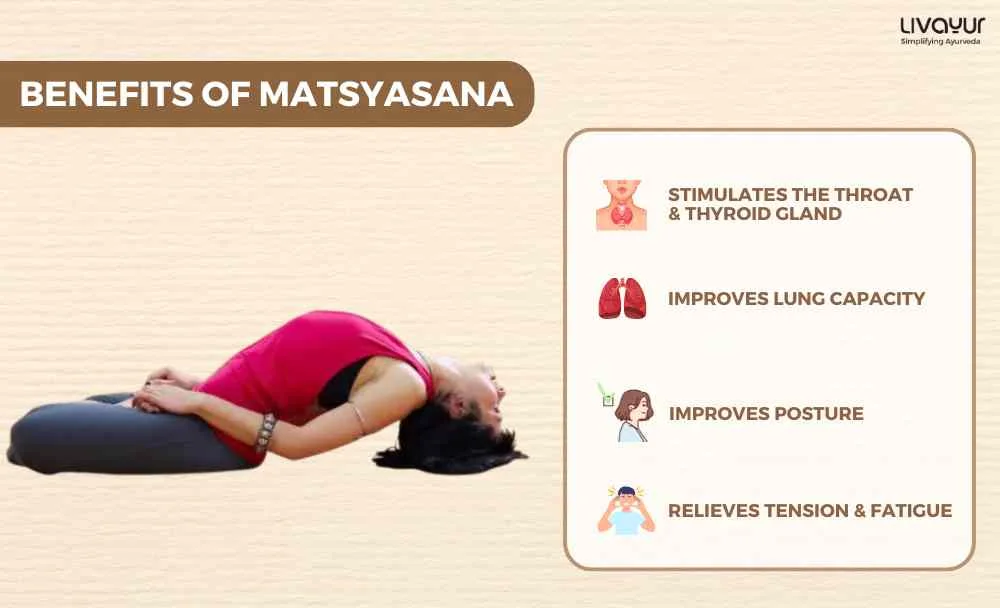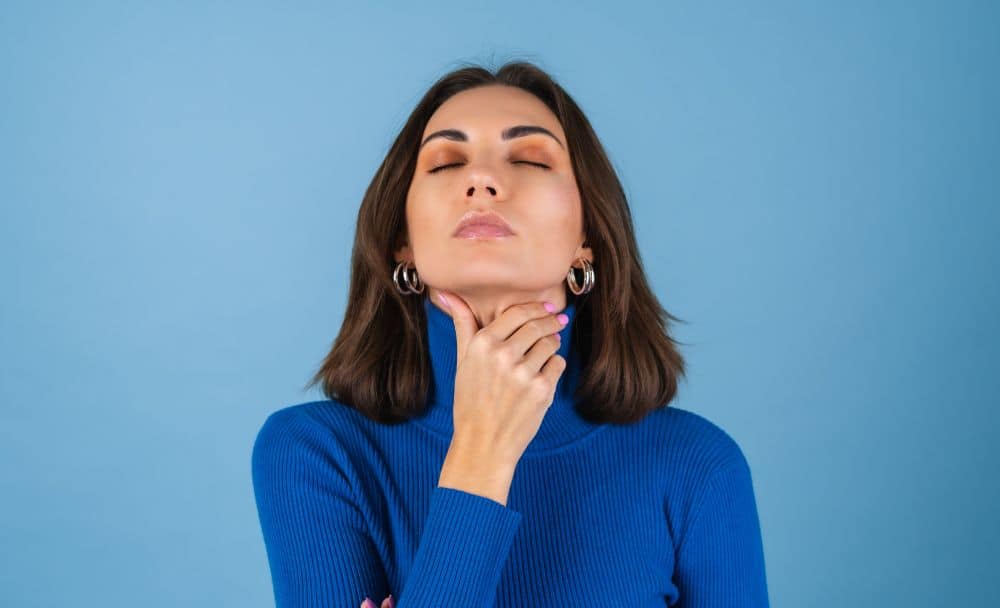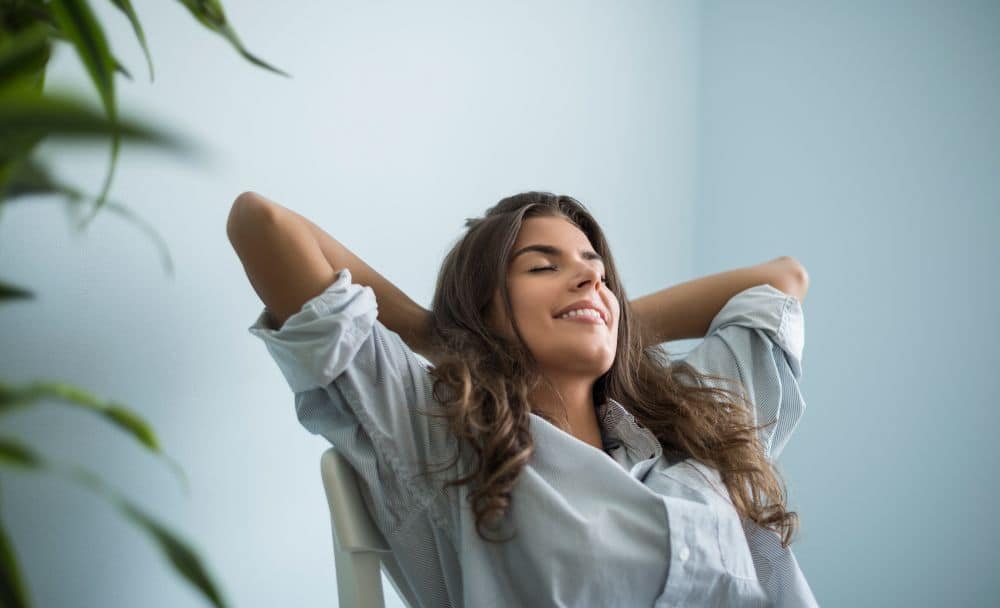
Matsyasana, also known as the Fish Pose, is a popular asana in the practice of yoga. It is named after the shape that the body takes while performing the pose, resembling a fish. Matsyasana offers a wide range of benefits for the body and mind, making it an important pose to incorporate into your yoga practice. In this article, we will explore the benefits of Matsyasana and provide a step-by-step guide on how to perform it correctly.
Benefits of Matsyasana
1. Stretches the chest and shoulders
One of the primary benefits of Matsyasana is its ability to stretch and open the chest and shoulders. This is especially beneficial for individuals who spend long hours sitting or hunched over a computer, as it helps counteract the effects of poor posture. By stretching these areas, Matsyasana improves posture and helps alleviate tension and tightness in the upper body. [1] [2]
2. Stimulates the throat and thyroid gland

The throat is an often-neglected area of the body, but it plays a crucial role in communication and self-expression. Matsyasana stimulates the throat, improving blood circulation and enhancing the functioning of the thyroid gland. This can help regulate metabolism and balance hormones, promoting overall health and well-being. [3]
3. Relieves respiratory issues
Matsyasana is a beneficial pose for individuals with respiratory problems. By opening up the chest and improving lung capacity, this pose can help alleviate conditions such as asthma and bronchitis. It also encourages deep breathing, which enhances oxygen intake and promotes relaxation. [4]
4. Enhances spinal flexibility
The Fish Pose is an excellent way to improve spinal flexibility. As you arch your back and lift your chest, the pose stretches and strengthens the muscles along the entire length of the spine. This can help reduce back pain, improve posture, and increase overall mobility. [5]
5. Relieves tension and fatigue

Matsyasana is known for its ability to relieve tension and fatigue. By opening the chest and shoulders, the pose releases stored tension in these areas, providing a sense of lightness and relaxation. It also helps stimulate the parasympathetic nervous system, which promotes rest and rejuvenation. [5]
A step-by-step guide to performing Matsyasana
1. Lie flat on your back on a yoga mat or a comfortable surface.
2. Place your hands palms down, underneath your hips. Adjust your hands so that your palms are pressed firmly into the ground.
3. Bring your elbows close to your sides and tuck them in toward your body.
4. As you inhale, press your forearms and elbows into the ground, lifting your chest and head off the mat.
5. Allow the crown of your head to gently rest on the ground, creating a slight arch in your upper back.
6. Keep your legs extended and your toes pointed.
7. Press the thighs and legs down into the mat, engaging the muscles of the lower body.
8. Relax your buttocks and allow your weight to be evenly distributed.
9. Breathe deeply and hold the pose for 30 seconds to 1 minute, or as long as is comfortable for you.
10. To release the pose, exhale and slowly lower your head and chest back down to the mat. You can extend your legs and rest in Savasana (Corpse Pose) for a few breaths.
Tips for practising Matsyasana
- If you have any neck injuries or discomfort, it’s important to modify the pose. Instead of allowing the head to rest on the ground, use a folded blanket or a yoga block for support.
- As with any yoga pose, listen to your body and practice at your own pace. Do not force or strain yourself.
- Warm up your body before attempting Matsyasana. Perform gentle neck and shoulder stretches to prepare the muscles and joints for the pose.
- It’s important to maintain proper alignment in Matsyasana. Keep your neck relaxed and elongated, and avoid straining or crunching the back of your neck. Instead, focus on lifting your chest and heart towards the ceiling.
- Engage your core muscles to support your lower back and maintain stability in the pose. This will also help prevent excessive compression in the lumbar spine.
- Take slow, deep breaths while in Matsyasana. Allow the breath to flow naturally and deepen the stretch with each inhalation and relaxation with each exhalation.
- If you experience any discomfort or pain during the pose, ease off or come out of it. Remember that yoga should be a gentle and mindful practice, and it’s important to honour your body’s limitations.
- Matsyasana can be practised as a standalone pose or as part of a sequence. It pairs well with other backbends and poses that open the chest and shoulders, such as Bhujangasana (Cobra Pose) or Ustrasana (Camel Pose).
- Consistency is key when practising yoga. Aim to incorporate Matsyasana into your regular yoga routine to experience its full benefits. Start with a few breaths in the pose and gradually work your way up to longer durations as your body becomes more comfortable.
FAQs
1. Is Matsyasana suitable for beginners?
Matsyasana can be practised by beginners, but it’s important to approach it with caution. Start by practising a modified version of the pose, using props like blankets or blocks for support. Gradually work your way up to the full expression of the pose as your flexibility and comfort level increase.
2. Can Matsyasana be practised by individuals with neck injuries?
If you have a neck injury or discomfort, it’s essential to modify Matsyasana to avoid strain. Instead of resting the head on the ground, use a folded blanket or a yoga block for support. This will help maintain proper alignment and protect the neck.
3. What are some preparatory poses that can help before practising Matsyasana?
Preparatory poses that can help warm up the body and open the chest and shoulders include gentle neck stretches, shoulder rolls, and poses like Bhujangasana (Cobra Pose) and Setu Bandhasana (Bridge Pose).
4. How long should I hold Matsyasana?
Hold Matsyasana for 30 seconds to 1 minute, or as long as is comfortable for you. Over time, you can gradually increase the duration of the pose as your body becomes more accustomed to it.
5. Can Matsyasana help with stress and anxiety?
Yes, Matsyasana can help alleviate stress and anxiety. The pose stimulates the parasympathetic nervous system, which promotes relaxation and a sense of calm. Combined with deep breathing, Matsyasana can be a beneficial practice for reducing stress and anxiety.
6. Are there any variations of Matsyasana?
Yes, there are variations of Matsyasana that can be practised to modify the intensity or target specific areas. One variation is Ardha Matsyasana (Half Fish Pose), where only one side of the body is lifted at a time. Another variation is Supta Matsyendrasana (Supine Spinal Twist), which combines a twist with the benefits of Matsyasana.
7. Can Matsyasana be practised during pregnancy?
It is advisable to avoid practising Matsyasana during pregnancy, especially in the later stages. The pose involves lying on the back, which can exert pressure on the abdomen and affect blood circulation. It’s best to consult with a qualified prenatal yoga instructor for suitable modifications and alternatives during pregnancy.
Conclusion
In conclusion, Matsyasana (The Fish Pose) offers a myriad of benefits for both the body and mind. From stretching the chest and shoulders to stimulating the throat and thyroid gland, this pose can help improve posture, enhance respiratory function, and promote relaxation. By following the step-by-step instructions and practising mindfulness, you can incorporate Matsyasana into your yoga practice and reap its rewards. Remember to always listen to your body, modify the pose as needed, and enjoy the journey of self-discovery and well-being that yoga brings.
Disclaimer: This Article is for informative purposes only and does not constitute medical advice. Kindly contact a medical professional before attempting any treatments mentioned in the article yourself.
References:
- Effect of Yogasanas and Pranayama on Pain, Severity and Quality of Life in Primary Dysmennorhea | International Journal of Medicine and Public Health (ijmedph.org)
- Study Of Yogasanas To Prevent Obesity | International journal of economic perspectives (ijeponline.com)
- Review Study Of Dhatwagnimandya (Hypothyroidism) And Its Ayurvedic Management(wjpr.net)
- Yoga for combat with COVID-19 epidemic (theyogicjournal.com)
- View of Yoga Intervention on Occupational Stress (jaims.in)

















